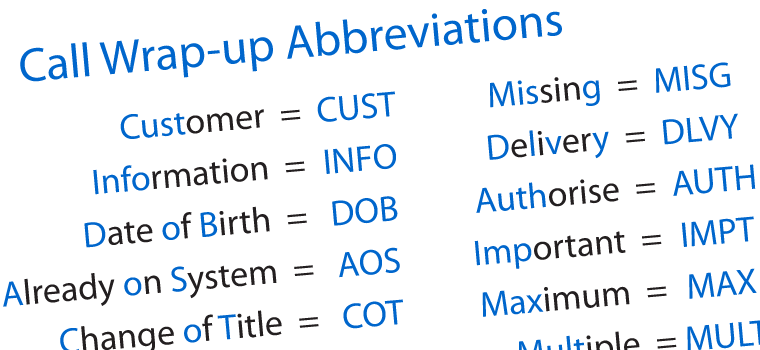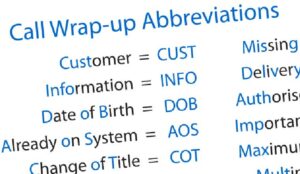Carolyn Blunt shares some ideas of how to reduce after call work.
Wrap time, after-call work (ACW) and post-call processing – these are just some of the names for that important bit of time in a contact centre once a call has ended when the advisor can update the system with the caller’s resolution, next steps, details or order notes. They may also need to make some outbound calls or send emails during this time to progress the caller’s resolution.
In one of our previous articles on ‘Balancing Customer Service and Efficiency’ we discussed how important it is to ensure that this time is used properly, and that advisors are not pressured into ‘doubling up’ this time as ‘ready’ or even worse, going through the greeting of the next call whilst still typing up the notes of the previous.
In this article we will show you how to make the most of just a few precious minutes to ensure wrap time is used properly and effectively. There are some wrap horror stories you may also wish to avoid…
1. The importance of quality call text
Train your advisors clearly on what is required in call text, logs or notes. This is critically important when another department, level of escalation or field operatives may be picking up the next steps.
2. Make it part of the call centre induction process
Train your advisors as part of their induction on how to use call text, what level of detail is needed and which abbreviations are acceptable – provide them with a list. Show them the bigger picture, i.e. explain who else looks at their call text and how the information is used. Explain the consequences (preferably with real case studies) of when poor call text has caused problems for the customer, organisation and advisor.
3. The need for speed
Teach them to proof read backwards and to type quickly and accurately. After six months of service hold a short ‘Call Text Etiquette’ workshop that refreshes the key points from induction.
4. Weed out any bad habits
In this workshop you can introduce training activities that include ‘spot the errors’ in sample call text paragraphs. In the workshop discuss what the implications of such errors could be, a) for the caller/customer, b) for the organisation and c) for them.
5. Manage time classifications
If advisors are not using wrap time for the purposes previously listed (updating the system, making required outbound calls or sending emails relating to the call, etc.) then they should be in ‘Not Ready’, ‘Make Busy’ or your equivalent. As a team leader or contact centre manager your overall wrap times will be hugely inflated if people are using these for loo breaks, chat time, drink refills, etc. Most contact centres do have targets on wrap time, which can vary depending on the type of centre, but often around 5% of average handling time is used. Explaining this diplomatically at a team briefing may be all that is needed for you to see an improvement in metrics.
6. Reuse and recycle
Calls can be quite repetitive, and this is something that can be used to our advantage in wrap time! Show advisors how to cut and paste chunks of call text between screens.
Consider making a process document of common best practice call text paragraphs, classified into the types of calls your advisors receive and send this to them electronically so that they can have it open on their desktop and paste across without re-writing standard advice/actions every time. Some of this text may also be useful to paste into emails, saving further time. However, do train them to use it with caution, details of individual calls (reference numbers, dates, names, amounts, etc.) should still be personalised and added to the standard information.
7. Get feedback
Find out how useful the call text is to the people that depend upon it (other departments, levels of escalation, field operatives, etc.). Are there details that are being entered that are not needed or are there key elements missing that would reduce chasing and follow-up to your advisors? If something is essential or not needed let your team know.
8. Analyse the Good, the Bad & the Ugly!
Review the statistics and quality of call text from a cross section of team members. What are the good ones doing that could be shared as best practice? Are there certain people that continually take longer in wrap or produce poor results? What coaching might they need?
9. Watch out for the horror stories
Are there any downright horror stories about wrap time that need to be tackled? For example, an IT helpdesk required advisors to complete call text about each call and the advice given. Call text could be accessed by the clients paying for the IT support service. Therefore when an advisor wrote ‘caller is a know-it-all and has made problem worse by trying own fixes – stupid w**ker’ he thought it would only be read by the 2nd line support desk. In fact, this was read by a senior decision maker in the client’s buying team. Not good when it comes to gaining contract renewals.
10. Watch out for wrap-up games
Equally, ‘games’ in call text that are devised to break the monotony of a team’s day are not good. For example. trying to get as many professional wrestling slang references into call text in a day was one example we found; ‘Have slammed this babyface’s problem. Call closed, clean finish.’ Whilst hugely entertaining for the advisors themselves, naturally it was not professional and anyone unschooled in the slang could not later decipher the meanings. Ensure you coach your team on what is efficient and effective use of wrap time and use specific praise to highlight good work.

Bonus Tip – Use Wrap Up Abbreviations
A quick way to speed wrap up time is to use call centre abbreviations to speed up the data entry process. It’s using abbreviations like CUST = Customer, INFO = Information, MULT = Multiple. These all reduce the number of key strokes that need to be typed.
Call Centre Helper have produced a comprehensive list of call centre abbreviations. Click here to access the list of contact centre wrap-up abbreviations.
Carolyn Blunt is a contact centre training expert with Real Results Training. If you found this article helpful you might also like our free report on motivating staff and improving performance. To request this freebie please contact Carolyn Blunt through the Real Results website www.real-results.co.uk.
Author: Jonty Pearce
Reviewed by: Megan Jones
Published On: 20th Aug 2008 - Last modified: 13th Jan 2025
Read more about - Hints and Tips, After Call Work (ACW), Carolyn Blunt




































Depending on the nature of your contact centre, there can be a number of walk-away/not ready reason codes which have a major impact on not ready time if they are abused. A common issue is that when an agent’s wrap time is high, they will use an alternative code instead, thus reducing wrap but increasing in another not ready code instead!
pleas be kind enough to send some motivational programs and to improve customer care
Hi,i your information has been so useful to my research on Call Centre Wrap up and request that i receive more related info on Call Centre but most of all Not Ready time and Team Motivatition,how to manage agent morale.
Thank you for this information…
Excellents tips…really usefull for me…thanks a lot
This is very helpful. thank you so much!